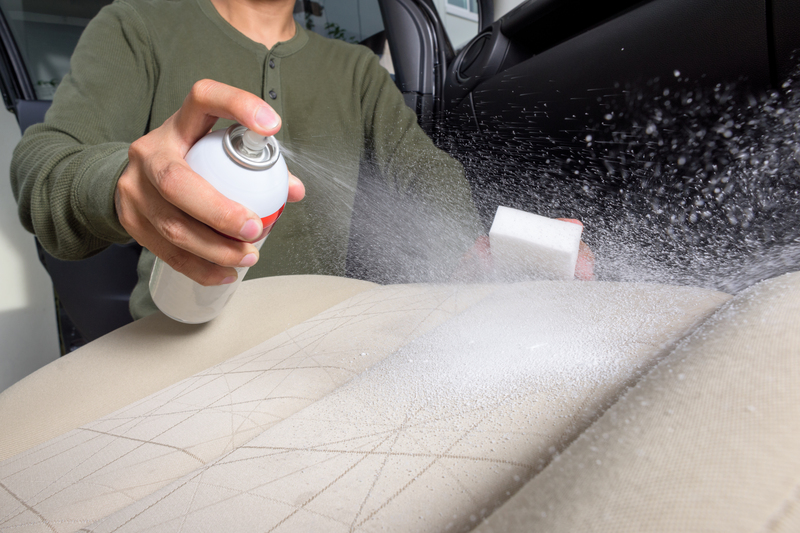Pro Car Wash Methods: Polish Like a Professional
Posted on 30/08/2025
Pro Car Wash Methods: Polish Like a Professional
Car enthusiasts and vehicle owners alike know that nothing beats the sight of a car shining brilliantly in the sunlight. Achieving that flawless, professional-grade finish isn't only for auto detailing shops--you can polish your car like the pros right at home! This comprehensive guide explores the best professional car wash techniques and reveals the secrets to polishing your vehicle like a true expert. Follow these step-by-step instructions to restore and maintain a mirror-like shine, boost your car's value, and protect its paint for the long haul.
Why Opt for Professional Car Polishing Methods?
Many DIY car washes leave vehicles with water spots, swirl marks, and dull finishes. However, professional car polish techniques are developed to bring out the best in your vehicle's paint, extend its longevity, and ensure a head-turning appearance. Here's why you should invest time in learning these valuable methods:
- Restore and Renew Paintwork: Remove minor scratches, oxidation, and swirl marks.
- Enhance Gloss and Shine: Achieve a deep, reflective finish like the pros.
- Protect Your Investment: Shield your paint from environmental contaminants and UV rays.
- Boost Resale Value: A well-maintained exterior increases your car's appeal to buyers.
- Satisfaction Guaranteed: There's nothing like the pride of a self-achieved, stunning finish.

Pro Car Wash Step-by-Step: From Washing to Polishing
To polish a car like a professional, it's essential to understand and execute each step with precision. High-end car detailing is a process--not a single task. Let's break the journey into clearly defined stages:
1. Pre-Wash: Preparing the Surface
Before any polish touches your car, meticulous preparation is critical. Even the best car polish won't perform miracles on a dirty or contaminated surface.
- Rinse Thoroughly: Use a hose or pressure washer to remove loose debris and dust.
- Apply a Snow Foam: Quality snow foam breaks down stubborn grime. Allow to dwell for 5-10 minutes.
- Two-Bucket Wash Method: Fill one bucket with soapy water, the other with clean water for rinsing your mitt. This reduces swirl marks.
- Microfiber Mitts Only: Avoid sponges. Microfiber is gentle and effective at trapping dirt.
- Dry Carefully: Pat dry with a plush microfiber towel to avoid scratches.
Tip: Wash and polish your car in the shade to prevent water spots and premature drying.
2. Decontamination: Iron Fallout and Clay Bar Treatment
Even after washing, invisible contaminants can cling to your paint. Professional car detailers use specialized tools to achieve a truly clean finish:
- Iron Remover: Spray on paintwork--especially wheels--to dissolve iron particles. Wait 3-5 minutes, then rinse.
- Clay Bar: Lubricate surface with clay lubricant and gently glide the clay bar over the paint. This process removes brake dust, sap, and other bonded contaminants.
Decontaminated paint feels perfectly smooth and is primed for polishing, allowing products to work more efficiently.
Choosing the Right Car Polish and Tools
The choice of polish and equipment is fundamental to achieving a professional-grade car finish.
- Machine vs. Hand Polishing:
- Dual Action (DA) Polishers: Safer for beginners, reduces the risk of burning through clear coat.
- Rotary Polishers: Preferred by pros for deep correction, but requires experience.
- Hand Polishing: Suitable for small areas or delicate touch-ups.
- Polishes:
- Compound Polish: Cuts through heavy oxidation and removes deeper defects.
- Finishing Polish: Refines the paint and boosts shine.
- All-in-One Polish: Offers correction and gloss in one step for quick jobs.
- Polishing Pads: Foam, microfiber, and wool pads each have distinct characteristics for specific tasks. Use soft foam for finishing, firmer for cutting.
Pro Tip: Always match the polish with the corresponding pad and test on a small area to ensure compatibility!
Step-by-Step Polishing: Polish Like an Expert
1. Masking Delicate Areas
Use painter's tape to protect rubber trim, plastic parts, and badging. These areas can be stained or damaged by aggressive compounds.
2. Sectioning and Methodical Approach
Divide your car's bodywork into manageable panels--like the hood, roof, and doors. Work on one section at a time for even results.
- Apply Polish: Place a small amount (2-4 pea-sized drops) on the pad.
- Spread Evenly: Dab the pad on the panel to distribute polish before turning on the polisher.
- Polish Slowly: Use overlapping passes--horizontal, then vertical. Don't apply excessive pressure.
- Wipe Down: Buff with a clean, dry microfiber towel to reveal results before moving on.
3. Correcting Paint Defects
- Swirl Marks: Address with medium cutting polish and pad. If they persist, consider a compound polish.
- Water Spots & Minor Scratches: Target these with a more aggressive pad, but never overwork or linger too long in one area.
How do you know when you've achieved optimal results? The paint should look glassy and reflect light sharply with minimal visible defects.
Finishing Touches: Ensuring Maximum Gloss & Protection
1. Paint Inspection
After polishing, examine your work under good lighting. Use an inspection lamp or sunlight to check for missed spots or remaining swirls.
2. Final Wipe-Down
Remove any smudges with a dedicated paint prep spray or isopropyl alcohol mix (diluted). This step ensures no residues remain before applying protection.
3. Protection: Wax, Sealants, and Ceramic Coatings
- Carnauba Wax: Delivers a warm, natural glow and water beading. Lasts up to 2-3 months.
- Paint Sealant: Synthetic polymers for longer protection (up to 6 months).
- Ceramic Coatings: Professional-level hardness, hydrophobicity, and up to 2+ years of durability. Application requires precise technique, but results are stunning.
Apply your chosen protection method with a soft applicator pad, using thin, even layers. Buff with a clean microfiber cloth for a flawless finish.
Advanced Pro Car Wash Methods for Next-Level Results
1. Wet Sanding (For Severe Defects)
This high-skill technique removes deep scratches and severe oxidation using ultra-fine sandpaper (2000-3000 grit) and plenty of lubrication. Wet sanding is not recommended for beginners--it can easily damage your clear coat if not done perfectly.
2. Multi-Step Polishing
Professional detailers often use multiple grades of polish, moving from heavy cut to fine finishing polish:
- Step 1: Compound for scratch removal
- Step 2: Medium polish for refining
- Step 3: Finishing polish for ultimate gloss
Each stage enhances clarity and shine.
3. Detailing the Details
Don't neglect:
- Door jambs (clean and polish as you would the rest of the paintwork)
- Chrome, glass, and plastic trim
- Engine bay and exhaust tips
True professionals pay attention to the finer points.
Top Expert Tips to Polish Your Car Like a Professional
- Work in a Dust-Free Area: A clean, enclosed garage prevents dust and pollen from settling on wet surfaces.
- Use High-Quality Microfiber: Cheap towels = scratches.
- Replace Pads Regularly: Old pads lose cutting and finishing ability.
- Keep Products Cool: Avoid using polish or waxes in extreme warmth or direct sunlight.
- Do Regular Maintenance: Once polished, future cleans will be easier and keep your car in showroom condition.
Polish like a professional and your car will not only look incredible--it'll be better protected against time, weather, and road hazards.
Common Polishing Mistakes to Avoid
- Skipping the Decontamination Step: Polishing over embedded dirt can cause micro-scratches and poor results.
- Using Too Much Product: More is not always better. Excess polish can mar surfaces and make removal difficult.
- Overheating the Paint: Move your polisher constantly--pausing in one spot can burn through clear coat.
- Neglecting Pad Maintenance: Clean pads between panels to avoid transferring contaminants.
- Polishing in Direct Sunlight: Causes products to dry too quickly, leading to streaks and holograms.

Pro Car Wash Method FAQs
How Often Should I Polish My Car?
Generally, a deep polish is recommended once or twice a year. More frequent polishing can thin your clear coat--regular washing and waxing in between will maintain results.
Can I Polish a Car by Hand?
Yes! While machine polishers are faster and deliver superior results with less effort, hand polishing is sufficient for small jobs, sensitive paint, or hard-to-reach areas.
What's the Difference Between Polishing and Waxing?
Polishing removes a fine layer of paint imperfections to restore gloss. Waxing adds a protective layer on top of polished paint to preserve the shine and prevent damage.
What Products Do Pros Use?
Leading brands include Meguiar's, Menzerna, Chemical Guys, Griot's Garage, 3M, and CarPro. Always choose products designed for your paint type and use pads suited to polish grades.
Conclusion: Make Your Car Shine Like a Pro
With the right knowledge, tools, and a bit of elbow grease, anyone can master professional car polishing techniques at home. By following these pro car wash methods and polishing your car like a professional, you'll not only improve its appearance but also extend the life of your paint. Treat your vehicle to a regular detailing routine, and you'll enjoy a gleaming, protected finish that turns heads--mile after mile.
Ready to achieve a stunning, showroom-quality car polish? Gather your supplies, put on your favorite tunes, and let's get detailing!




